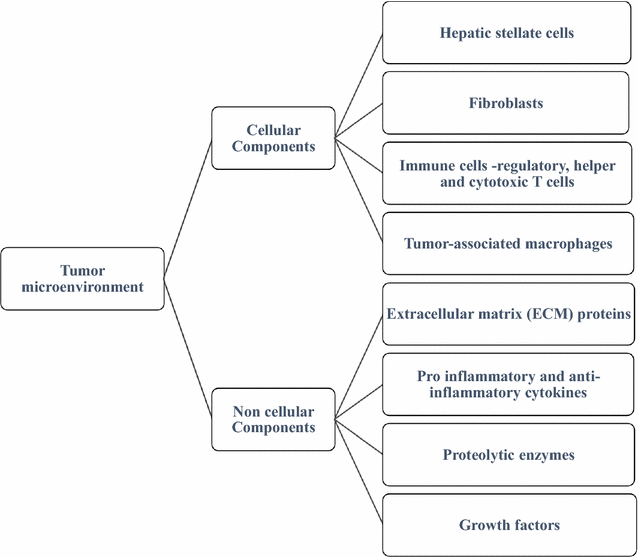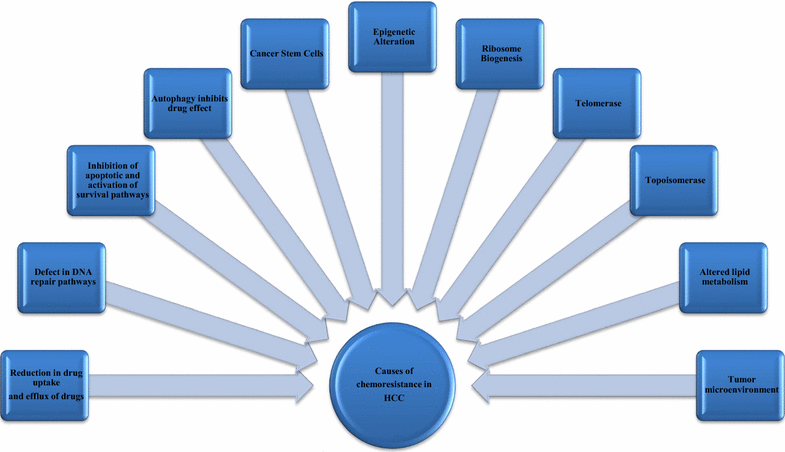Resistance a major hindrance to chemotherapy in hepatocellular carcinoma: an insight
- PMID: 29568237
- PMCID: PMC5859782
- DOI: 10.1186/s12935-018-0538-7
Resistance a major hindrance to chemotherapy in hepatocellular carcinoma: an insight
Abstract
Hepatocellular carcinoma (HCC) is one of the leading causes of cancer mortality, accounting for almost 90% of total liver cancer burden. Surgical resection followed by adjuvant and systemic chemotherapy are the most meticulously followed treatment procedures but the complex etiology and high metastatic potential of the disease renders surgical treatment futile in majority of the cases. Another hindrance to the scenario is the acquired resistance to drugs resulting in relapse of the disease. Hence, to provide insights into development of novel therapeutic targets and diagnostic biomarkers, this review focuses on the various molecular mechanisms underlying chemoresistance in HCC. We have provided a comprehensive summary of the various strategies adopted by HCC cells, extending from apoptosis evasion, autophagy activation, drug expulsion to epigenetic transformation as modes of therapy resistance. The role of stem cells in imparting chemoresistance is also discussed. Furthermore, the review also focuses on how this knowledge might be exploited for the development of an effective, prospective therapy against HCC.
Keywords: Apoptosis; Autophagy; Cancer; Chemoresistance; HCC; Metastasis.
Figures
Similar articles
-
Noncoding RNA-mediated molecular bases of chemotherapy resistance in hepatocellular carcinoma.Cancer Cell Int. 2022 Aug 9;22(1):249. doi: 10.1186/s12935-022-02643-6. Cancer Cell Int. 2022. PMID: 35945536 Free PMC article. Review.
-
Autophagy orchestrates resistance in hepatocellular carcinoma cells.Biomed Pharmacother. 2023 May;161:114487. doi: 10.1016/j.biopha.2023.114487. Epub 2023 Mar 22. Biomed Pharmacother. 2023. PMID: 36963361 Review.
-
Secretory Clusterin: A Promising Target for Chemoresistance of Hepatocellular Carcinoma.Mini Rev Med Chem. 2020;20(12):1153-1165. doi: 10.2174/1389557520666200331072122. Mini Rev Med Chem. 2020. PMID: 32228422 Review.
-
A novel strategy for the diagnosis, prognosis, treatment, and chemoresistance of hepatocellular carcinoma: DNA methylation.Med Res Rev. 2020 Sep;40(5):1973-2018. doi: 10.1002/med.21696. Epub 2020 Jun 11. Med Res Rev. 2020. PMID: 32525219 Review.
-
Targeting autophagy in chemotherapy-resistant of hepatocellular carcinoma.Am J Cancer Res. 2018 Mar 1;8(3):354-365. eCollection 2018. Am J Cancer Res. 2018. PMID: 29636994 Free PMC article. Review.
Cited by
-
CAR-NK cells for gastrointestinal cancer immunotherapy: from bench to bedside.Mol Cancer. 2024 Oct 23;23(1):237. doi: 10.1186/s12943-024-02151-3. Mol Cancer. 2024. PMID: 39443938 Free PMC article. Review.
-
Clinical significance and functional role of transmembrane protein 47 (TMEM47) in chemoresistance of hepatocellular carcinoma.Int J Oncol. 2020 Oct;57(4):956-966. doi: 10.3892/ijo.2020.5104. Epub 2020 Jul 28. Int J Oncol. 2020. PMID: 32945373 Free PMC article.
-
13-Acetoxysarcocrassolide induces apoptosis in human hepatocellular carcinoma cells through mitochondrial dysfunction and suppression of the PI3K/AKT/mTOR/p70S6K signalling pathway.Pharm Biol. 2022 Dec;60(1):2276-2285. doi: 10.1080/13880209.2022.2145489. Pharm Biol. 2022. PMID: 36416062 Free PMC article.
-
The combination of the glycolysis inhibitor 2-DG and sorafenib can be effective against sorafenib-tolerant persister cancer cells.Onco Targets Ther. 2019 Jul 8;12:5359-5373. doi: 10.2147/OTT.S212465. eCollection 2019. Onco Targets Ther. 2019. PMID: 31371980 Free PMC article.
-
Zebrafish as a Useful Model System for Human Liver Disease.Cells. 2023 Sep 11;12(18):2246. doi: 10.3390/cells12182246. Cells. 2023. PMID: 37759472 Free PMC article. Review.
References
-
- Raoul JL. Natural history of hepatocellular carcinoma and current treatment options. Semin Nucl Med. 2008;37(2):S13–8. - PubMed
-
- Chuma M, Terashita K, Sakamoto N. New molecularly targeted therapies against advanced hepatocellular carcinoma: from molecular pathogenesis to clinical trials and future directions. Hepatol Res. 2015; 45(10):E1–11. - PubMed
-
- Llovet JM, Villanueva A, Lachenmayer A, Finn RS. Advances in targeted therapies for hepatocellular carcinoma in the genomic era. Nat Rev Clin Oncol. 2015;12(7):408–424. - PubMed
-
- Lencioni R, Cioni D, Crocetti L, Franchini C, Pina CD, Lera J, et al. Early-Stage hepatocellular carcinoma in patients with cirrhosis: long-term results of percutaneous image-guided radiofrequency ablation 1. Radiology. 2005;234(3):961–967. - PubMed
Publication types
LinkOut - more resources
Full Text Sources
Other Literature Sources



